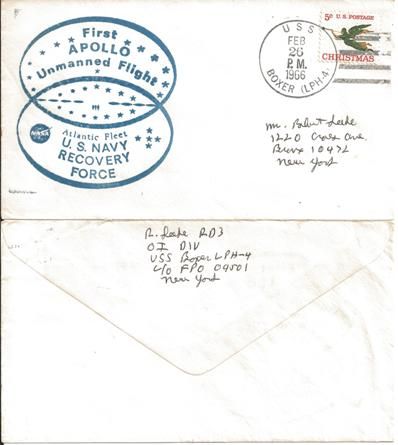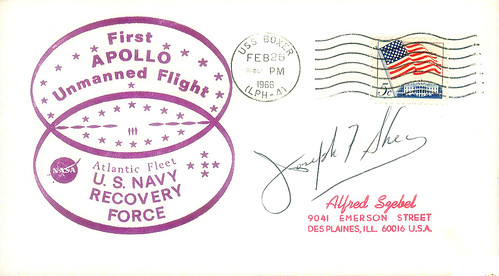Space Cover #240: AS 201Apollo-Saturn 201 (AS-201) flown on February 26, 1966, was the first unmanned test flight of an entire production Block I Apollo Command/Service Module and the Saturn IB launch vehicle. The spacecraft consisted of the second Block I command module and the first Block I service module. The suborbital flight was a partially successful demonstration of the service propulsion system and the reaction control systems of both modules, and successfully demonstrated the capability of the Command Module's heat shield to survive re-entry from low Earth orbit.
This first flight of the Saturn IB lifted off from Space Launch Complex (SLC) 34. The first stage worked perfectly lifting the rocket to 57 km, when the S-IVB J-2 engine took over and accelerated Apollo CSM to 29,000 kilometers per hour lifting the spacecraft to 425 km. The CSM separated and continued upwards to 488 km apogee.
The CSM then fired its own engine to accelerate the spacecraft towards Earth. The first burn lasted for 184 seconds. It then fired ten seconds later for ten seconds. This proved that the engine could restart in space, a crucial part of any manned flight to the Moon.
It entered the atmosphere traveling 8300 m/s. It splashed down only 37 minutes after launch, 72 km from the planned touchdown point 8,472 km downrange, east of Ascension Island and was on board the USS Boxer two hours later. Now for more of the story from a participant...
The cover above was sent from the USS Boxer on the day of the recovery by Robert John Seeke, RD3, of the OI Division aboard the USS Boxer. Describing his role in the AS-201 mission aboard the USS Boxer he writes:
At the time of the AS201 launch I was a radarman third class (RD3) on the U.S.S. Boxer LPH-4. Most of my time was spent in the Combat Information Center (CIC), where the radar scopes and plotting boards were located and manned 24 hours a day.There was training aboard the Boxer in preparation for the recovery of the AS201 capsule. The radar division (Operational Intelligence Div.) had no part in the training, other than our on-going training and practice drills.
When the day of the AS201 launch arrived the Combat Information Center (CIC) had more than its usual allotment of one or two officers on hand. These included the CIC officer LCDR. Brown and the Operations officer whose name escapes me, as I had very little contact with him.
Everyone was at their assigned duty stations. Mine was the surface radar to track the capsule after it splashed down. The mission commands were piped in to the CIC so we would know what was happening. With about 10 minutes to go before launch, a hold was placed on the launch. The groan from CIC could probably be heard at the launch site. The hold lasted about 10 minutes, then AS201 launched.
The entire flight, from launch to splashdown, was about 15 minutes. Boxer was close to the splashdown point and the capsule appeared on my radar screen. Range and distance to the capsule were quickly sent to the bridge and the ship steered toward the capsule. Once the ship was along-side the capsule, my job was done. I asked LCDR. Brown (he was a good guy) if I could be relieved and go take pictures. He said yes, and I went to one of the flying bridges on the starboard side near the recovery equipment. I was able to get good pictures of the recovery.
That ended CIC's involvement in the recovery of AS201. The crew never saw the capsule again, as it was moved below-decks and wrapped before it was off-loaded. I don't recall where that was.
/s/Robert John Seeke
It is always interesting to know the history behind the names that appear on the covers in our collections. That is what our hobby is... preserving history!














